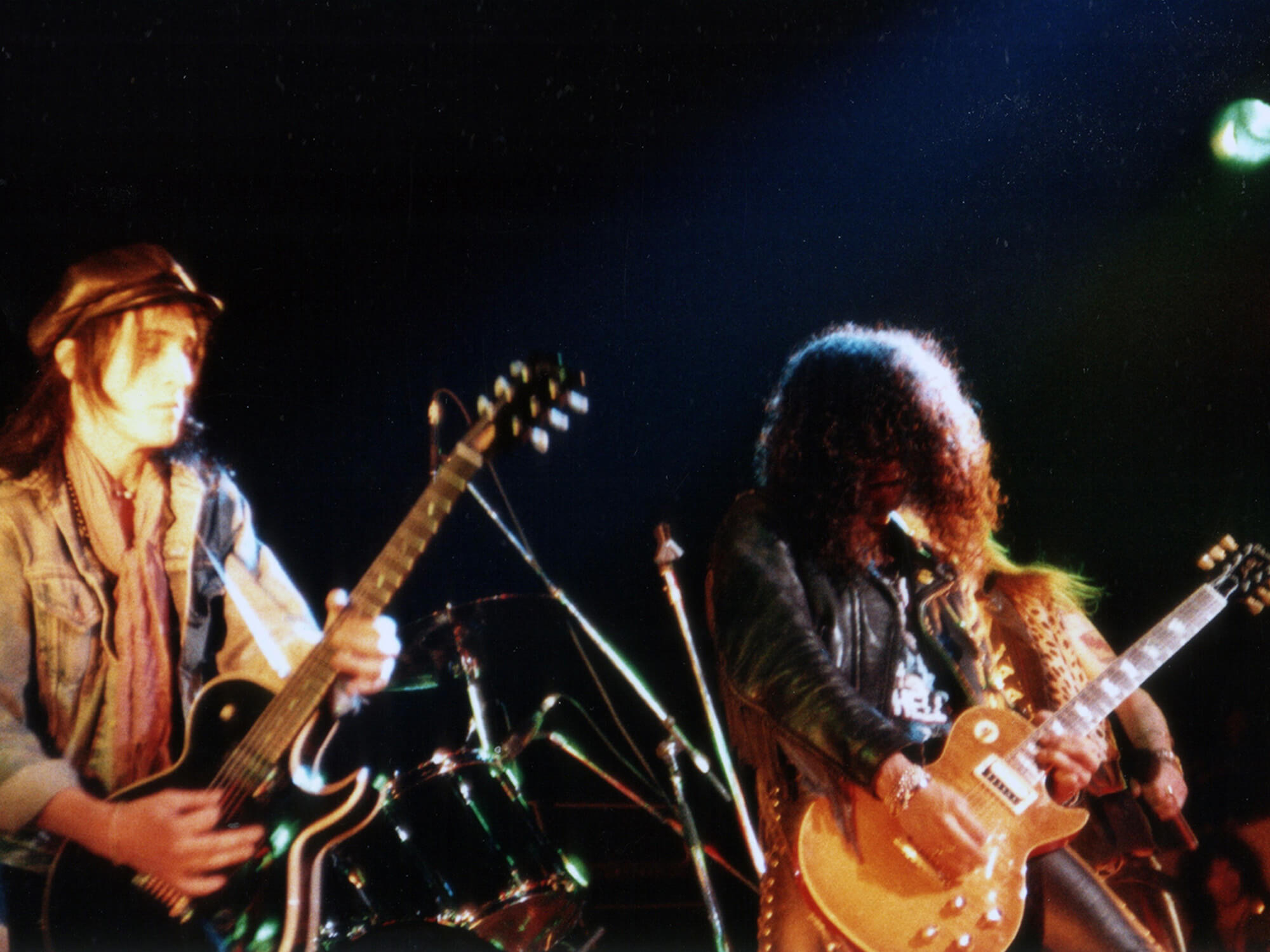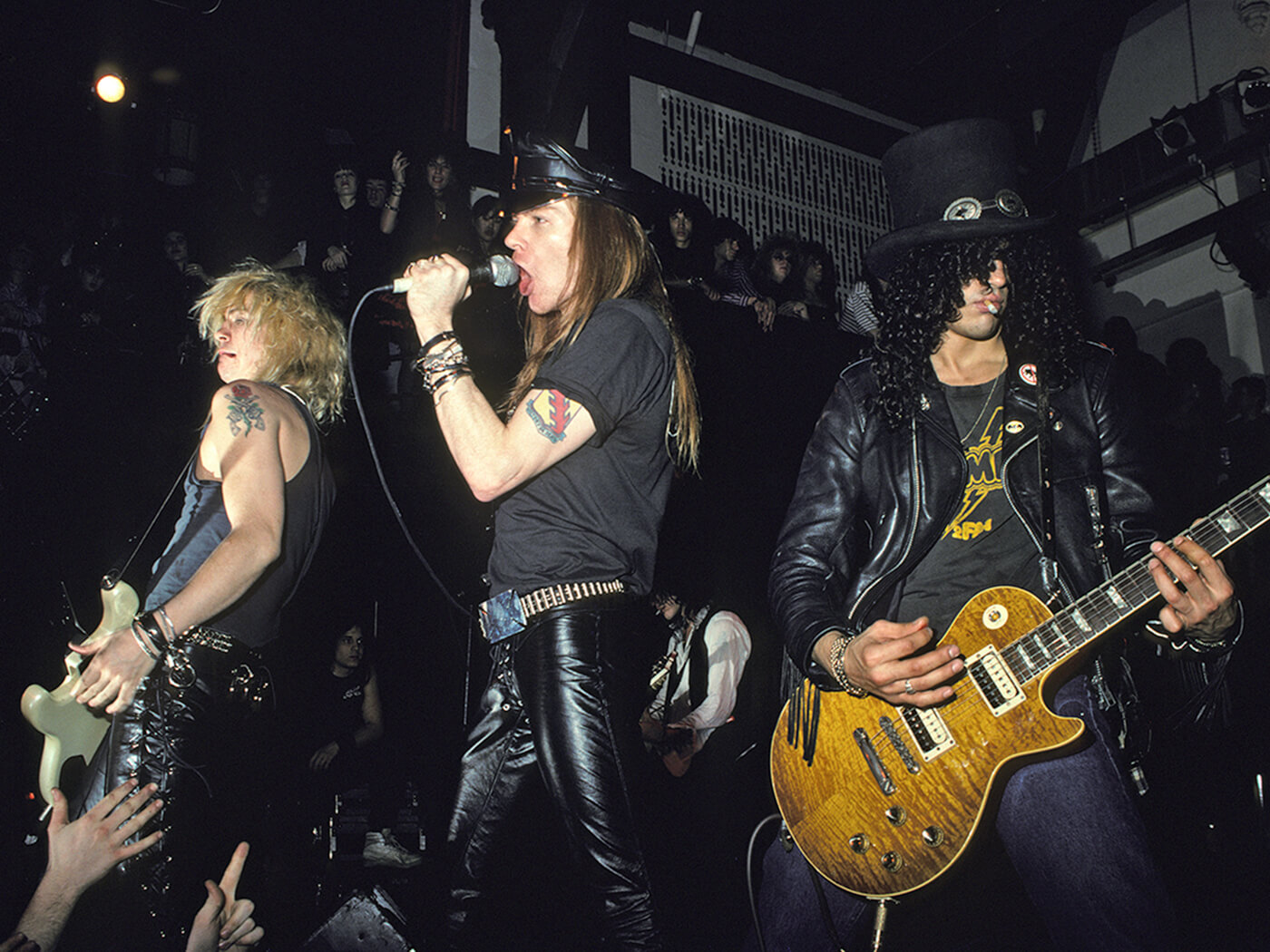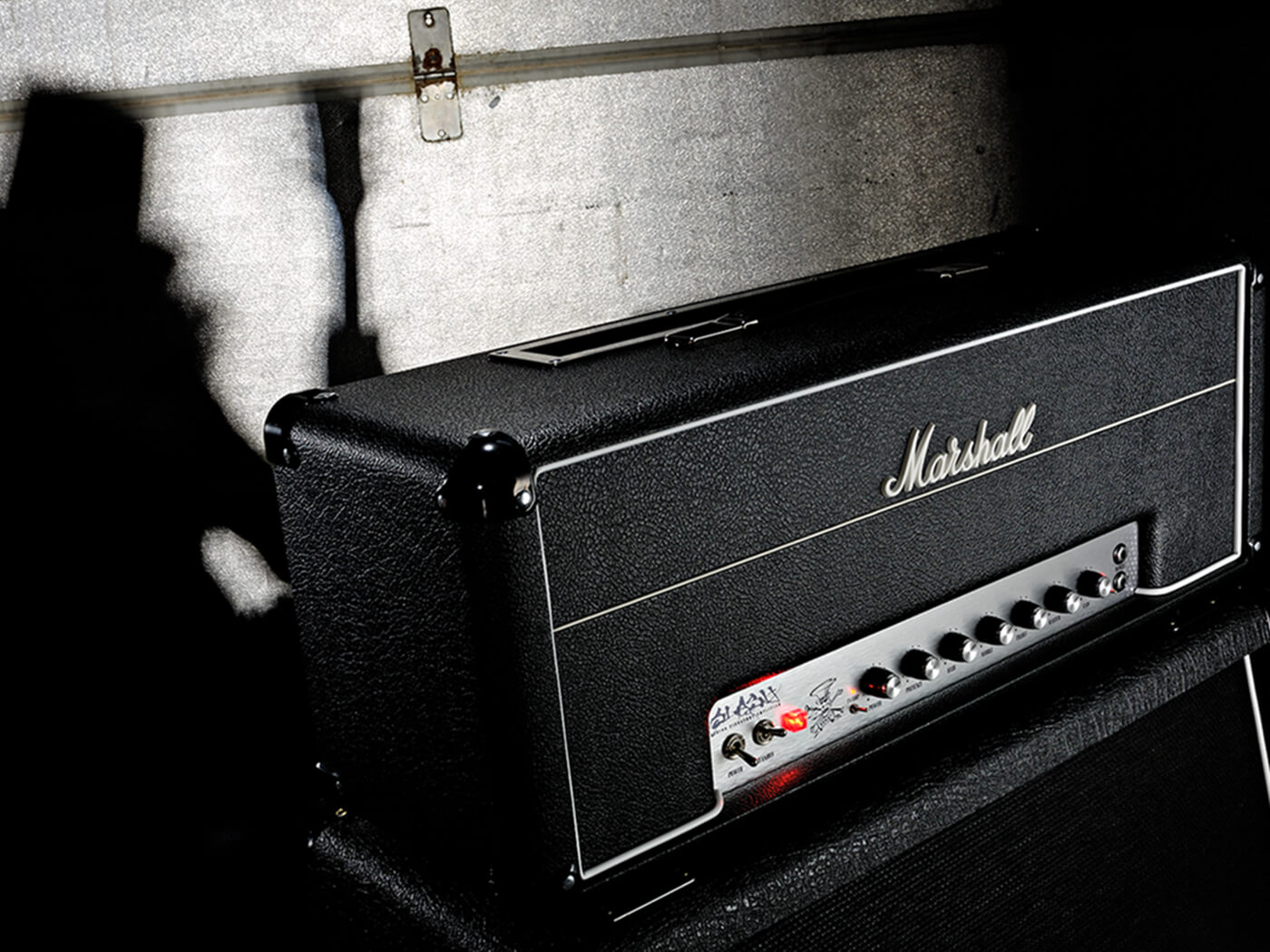The Gear Used by Slash on Guns N’ Roses’ Appetite For Destruction
His guitar work became the stuff of legend and his throwback tone a benchmark for millions of players around the world… but how exactly did he get it?

Izzy Stradlin and Slash at the Roy Wilkins Auditorium in St. Paul, Minnesota on December 17, 1987. Image: Jim Steinfeldt/Michael Ochs Archives vis Getty Images
Back in 1987, Guns N’ Roses entered the studio to record their major label debut. The resulting album, Appetite For Destruction, would go on to be one of the best-selling and widely celebrated albums of all time. In a single stroke the album thrust old-school guitars and amps back into the conversation after a decade of rackmounts and digital expansion, and made Slash a global sensation. In this article, we will explore the gear used by Slash to record some of the most iconic tracks in music history.
The Guitars

Prior to the recording of AFD, Slash was broke and had sold his favourite guitar, a Les Paul made by luthier Max Baranet. “In the early days of Guns, I had this great guitar that I picked up from Guitars R Us in Hollywood,” Slash says in the recent book, Slash: The Collection. “It was called the Hunter Burst after Steve Hunter from Alice Cooper’s band, and it was made by Max Baranet. At some point along the way, I somehow lost that guitar. Well, I didn’t lose it; I traded or sold it because I needed something else that seemed like a priority at the time!”
As a result he was playing B.C. Rich Warlocks and Mockingbirds and had even borrowed a black Stratocaster from someone for a show or two. He was playing whatever he could get his hands on, as he recalls in a 2010 interview with Noisecreep, “I was really broke and I hocked all my decent guitars before we went into the studio to make Appetite for Destruction, all I had left were a B.C. Rich Warlock and two Jackson guitars – a Firebird, and a prototype archtop Strat-style guitar.”
By the time he came to actually record the guitars on Appetite… in January 1987, he was down to just the Mockingbird and the archtop Jackson – and while they might have cut the mustard in a live setting, they were soon shown up under the microscope of studio conditions.
“I had the BC Rich Warlock, and I had the Jackson archtop Fender-style guitar with a whammy bar on it,” he says in Slash: The Collection. “That’s what I went into the studio to start doing basic tracks for Appetite with. All things considered, those guitars sounded okay for live performances. I was getting through the gigs. Obviously it wasn’t such a pressing issue at the time. And I didn’t have any money, so I was just tolerating these guitars.
“But as soon as we went into the studio and I started listening back to the takes, I was like, ‘Oh god, these sound horrible!’ It was a real dilemma, and fortunately my manager came through with the guitar at the eleventh hour. At the very last minute, right when I was going in to do guitar overdubs, that’s when I got the Derrig from our manager.”
‘The Derrig’ is the infamous Les Paul copy made by a luthier by the name of Kris Derrig – it was a beautifully crafted guitar bought by the band’s manager for him in the wake of those first sessions, and it would become the guitar that spawned millions of imitators – when we think of Slash, and we think of Guns N’ Roses, it’s this guitar we’re hearing, and it’s not even a real Gibson.
Kris’ guitars were not exact replicas, although they did have the Gibson logo on the headstock. Slash’s was fitted with Seymour Duncan Alnico II Zebra pickups and had a thinner neck profile than a Gibson. Kris’ son, Dale, estimates that his dad made “about 20, maybe more” of these Les Paul replicas. Slash later tracked one down and now owns three of them. Many of the replicas were possibly passed off as Gibsons and lost to the world. Lenny Kravitz and Charlie Daniels have both claimed to own one as well.
We all know that Gibson has a major distaste for forgeries and replicas, the irony here is that one of their most iconic signature series guitars is actually a replica of a replica. Tragically, Kris passed away due to throat cancer in 1987, a few months prior to the release of AFD, never getting the credit he truly deserved. Derrig’s Les Paul copy was the guitar heard throughout the Appetite For Destruction album and is still used to this day alongside the many Gibson versions inspired by the instrument.

According to Slash: The Collection, there was also another guitar involved in the recording – a 1961 Gibson SG that he used to track the rhythm part of My Michelle. This guitar would end up getting rammed through the front windshield of the GNR tour van in the parking lot of Take One Studios, in order to provide a suitably rock ‘n’ roll backdrop for Slash to be photographed by longtime Guns snapper Robert John later in 1987.
The Amp
For their major label debut, the band was given a budget of $370,000 including advances and according to Slash’s autobiography, rather than shopping for gear, he spent his advance on heroin. As a result, Slash ended up renting gear for the recording. Slash went into S.I.R. (Studio Instrument Rentals) to test out amplifiers to use on the album and landed on a Marshall Model 1959T Super Lead Tremolo – pre-master volume but post-Plexi (it had a metal faceplate) that had been modded by S.I.R. employee Tim Caswell. This amp was known as “Stock #39”. Slash specifically requested Stock #39 from S.I.R. but unfortunately, George Lynch had rented the amp to use on Dokken’s 1986 Tour and it wasn’t available. The company had an obligation to deliver a comparable amp, and this is where the story gets a bit convoluted.
Contrary to the misleading stencil, Tim modded Stock #39 by taking the amp’s unused tremolo circuit which had an additional tube and turning it into an extra preamp stage. The amp sported EL34 power tubes (they were typically shipped to the US with 6550s in those days). He also added a master volume. The amp that was actually delivered to the band was Stock #36, which had been modded by Frank Levi after Tim Caswell had left the company, but S.I.R. never told anyone, including Slash, that he was getting a different amp than requested. They were very similar but not exactly the same. Stock #36 did not have tremolo circuit to convert so they had to place the extra pre-amp stage elsewhere in the amp.

Slash never seemed to notice and was very happy with #36. So much so, that he began to scheme on how to keep the amp after the sessions. He offered to buy it and the company refused. So he ducked their calls for a while and finally lied to them and told them it had been stolen. S.I.R. supervisor Glenn Buckley suspected that Slash still had the amp and had his people looking everywhere for it.
Eventually one of Glenn’s employees called him up and said they had seen the amp at Stage 6 (a rehearsal space owned by S.I.R.) where the band was rehearsing for their 1987 tour with The Cult. Glenn personally went down to Stage 6, with some extra muscle of course, to get his amp back. In what turned out to be a rather anti-climactic end, the band wasn’t there when he arrived, and he simply grabbed the amp and walked out with it.
According to Glenn, Slash never said anything to him about the amp after that. But Slash has publicly decried his “idiot” tech at the time for bringing it to the rehearsal space, telling Guitar Magazine in 1992, “I had [a perfect amp] when I did Appetite, which was great. I stole it from S.I.R., and when we were rehearsing at S.I.R. after the record came out, my idiot roadie at the time brought that amp down by mistake, and they took it back. When we went back into the studio a couple years later, I had to find the ultimate amp again…”
Of course, these days Slash has a couple versions of his signature amp available through Marshall.

The amp was played through a Marshall 4×12 cabinet with Celestion 30s. As for effects, Slash used an MXR Analog Chorus, a Dunlop Crybaby Wah, and a Roland SRV-2000 Digital Reverb. The Roland was set to the “secret” delay mode, which can be found by holding down the Reverb/Non Linear, Write and Room Simulate buttons while powering on. That was the tone on Welcome To The Jungle while the more conventional settings were used elsewhere on the album.
A lot is made of Slash’s tone on the album, but I would be remised if we didn’t mention anything about Izzy Stradlin’s setup. The unsung hero of AFD used several different guitars on the record but most notably, a 1987 Gibson ES-175D which was recently auctioned off. As for amps, he reportedly used a Fender Bassman 60s Blackface head with Mesa Boogie 4×12 cabinet with EV speakers in the bottom and Celestions on top.




